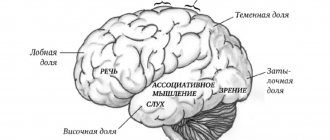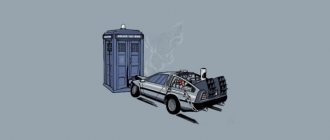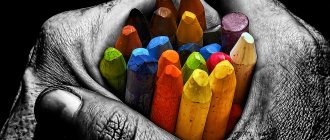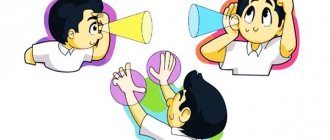Previous article Managing Emotions
Our world is unreal, we live in a matrix. Everyone knows the 1999 film, which for the first time brought to a wide audience the idea that the world may not be the same as we see it. Like everything that makes an impression and takes root in the mass consciousness, there is a large grain of truth in this idea. Let's find out to what extent the world is illusory and how capable each of us is of becoming the “chosen one” to bend the matrix to our will.
To answer the question, we will talk about perception. First of all, this mental process must be understood as a mechanism for transforming signals coming from the external environment into images that are stored in memory, emotionally colored and become available for mental operations. Depending on the sense organs, the following types of perception are distinguished: vision, hearing, smell, touch, taste, kinesthesia. In the process of active learning, connections are formed between analyzers that allow the formation of images containing properties or phenomena for the recording of which there are no separate sense organs: the size of the object, weight, shape.
A holistic image of an object, formed with the help of all connected senses, makes it possible to imagine what actions can be performed in relation to the object and what consequences can be expected.
An important feature of perception is that it is not accessible to introspection; we cannot feel the physiological process of its operation. We do not feel events developing within ourselves, in our brain, but we perceive the properties of things outside of us as external. The image of reality is formed only when objects of the external world influence the analyzers. This paradox provides an explanation why the characteristics of mental functions cannot be inferred from the patterns of brain functioning. It is impossible to comprehend the secret of the psyche with the help of purely physiological experiments; it cannot be reliably said that some part of the brain is responsible for a specific mental process. To understand the work of the psyche, it is necessary to take into account the diversity of a person’s external social connections.
Individual image of the surrounding world
Perception is a mental reflection of the properties of surrounding objects. We are, in a sense, a mirror of this world that reflects to itself. Each specific image is unique, as it is associated with the situation of its occurrence, the relationship between objects, and the motives in connection with which this image was recorded. Therefore, it is impossible for a person to exist whose psyche reflects the world exactly as it really is.
The way we perceive the world is the result of the perception “program” that was laid in us from childhood. For a child, every adult is a teacher who tells how to interpret what he sees. It turns out that a child’s image of the world is a set of interpretations of the adults who communicate with him. Often these interpretations are erroneous and contradict each other. Even in adults, perception is distorted under the influence of likes, dislikes, and fears.
Imagine the color green. If you are not colorblind, you will always recognize it, and other people will confirm that it is indeed green. But calling the color “green” is what you were taught. People agreed among themselves that we would call this type of color green. But in reality, everyone can see this color differently.
That part of reality that is consistent with previous experience is perceived. A person is not able to see something outside of his life experience if it is something so new that it does not cause any associations. For example, tribes living in isolation, over which air corridors pass, do not notice flying planes at all.
In addition, everyone perceives reality from the “angle of view” of their needs, interests, attitudes, motivation, under the pressure of the need to control behavior. The pedestrian does not pay attention to traffic signs, but the driver perceives them even with peripheral vision. An architect, looking at a building, pays attention to some details, and a doctor to others. An angry person and a lover see the world with different eyes. If you urgently need to dig a hole, but there is no shovel, then the analyzers will be configured to search for hard and flat objects. Even when conscious search is stopped, you will pay attention to objects with the desired properties. Only that which is significant for controlling behavior is perceived and recorded in memory.
The influence of attitudes has its own specifics. With the help of psychological defense mechanisms, incoming information is distorted so that the ingrained attitude is confirmed. For example, a complex person with the belief “I’m nothing of myself” may not hear or see evidence of his real successes, and may perceive sincere compliments as flattery or mockery. The evil one will see an enemy in every person, and in the world around him he will notice only negative information that confirms his ideas. A person who considers himself a failure will unconsciously lead himself to failure with every movement, every reaction, every word. But then he can again complain, “I always knew that nothing would work out.”
It is common for a person to highlight certain aspects of the environment more than others in the process of perception to the extent that they correspond to his goals and intentions, the characteristics of the activity in which he is engaged, and personal characteristics. This entire set of factors is defined as human experience, and the dependence of the perception process on past experience is called apperception. Translated from Latin, this term means “at perception, to perception.” Indeed, a person seems to apply his experience to perception. This experience allows you to fill the sensory material of the image with a certain meaning.
There is a large amount of factual material illustrating phenomena associated with selectivity of perception and apperception.
Many of these facts would have been known in the last century. Thus, the American psychologist William James explains the phenomenon of apperception with the following examples: “Some residents of Polynesia, seeing horses for the first time, began to call them pigs, since the rubric “pigs” was in their experience the most suitable for a never-before-seen animal - a horse. My two-year-old son played for a whole week with an orange he saw for the first time, calling it a ball. He was fed soft-boiled eggs, which were served to him without the shell in liquid form, poured into a glass; when the child saw a whole egg for the first time, he called it a potato, since he had previously seen and eaten potatoes without skin and knew their name.”
Phenomena associated with selectivity of perception have been widely studied in modern psychology.
One of the interesting phenomena associated with selectivity of perception is the “party effect” discovered by K. Cherry. It is widely known to each of us: at a party, guests are divided into groups, each of which discusses a particular topic. To a stranger who accidentally enters the room where guests are, it seems that those talking should interfere with each other. Meanwhile, it is enough to join the conversation, and everything else ceases to be noticed. This phenomenon has been intensively studied experimentally using the dichotic listening technique. In this case, two different magnetic recordings were fed through headphones into the subject’s two ears. When the experimenter asked the subject to listen carefully to one of them, the subject easily repeated the words and phrases he heard. But he did not catch anything from another recording, even when a certain word was repeated in this recording up to 35 times! Such tracking of messages is carried out on the basis of semantic characteristics. So, if the subject follows what is being sent to him in his right ear and if suddenly this message begins to be transmitted through his left, then he can easily continue to follow it. The choice of information to which a person pays attention in dichotic tracking experiments depends largely on his past experience.
Children from Mexico and the United States had two pictures projected into their left and right eyes using a stereoscope. One of them included a scene from Mexican life, and the second from North American life. In this experiment, the subject could not integrate them into a holistic image and perceived only one of the two scenes. It was noted that when such two objects were simultaneously presented, such as, for example, images of a bullfighter and a baseball player, Mexican children more often saw only the first of them, and American children - the second. Thus, they “tuned” their perceptions based on past experiences, differences in which are culturally determined. In addition to stable apperception, which is determined by the peculiarities of the subject’s life experience, temporary apperception may also occur. It reflects the influence of situationally arising mental states, such as attitudes, emotions, various kinds of expectations, etc.
In one of the experiments, subjects were offered to read German words in Latin transcription in a short exposition, which caused and fixed an attitude toward reading foreign words in the corresponding transcription. After this, Russian words were exposed, but consisting of letters whose configuration is found in both Russian and Latin transcriptions, for example, Neva. It turned out that most of the subjects read such words as foreign, although unfamiliar (for example, Heba). The attitude fixed on reading foreign words contributed to the transformation of well-known Russian words into meaningless complexes of sounds depicted in Latin script. The phenomenon of apperception must also be taken into account in teaching. At the same time, the teacher should remember that any fact he presents will be perceived taking into account the characteristics of the student’s past experience.
An expressive example showing the importance of taking into account the characteristics of a student’s past experience in the teaching process is given by L.S. Vyvgotsky: “During the fall of the Soviet currency (i.e. immediately after the revolution - Author), children became accustomed to handling enormous astronomical figures every day, and many teachers noticed that when they had to tell children real astronomical figures, it gave a completely unexpected effect. So, the boy, having heard that the length of the earth’s equator is 40,000 miles, said: “So little, a glass of sunflower seeds costs the same amount of rubles.” The meaning of large numbers was so compromised in the student’s experience that the children could not understand why, when they wanted to depict enormous distances, they operated with such numbers that they had the impression that these were insignificant quantities.”
(or selectivity of perception; English perceptual selectivity) - a property of perception consisting in the selection of something from the sensory field. objects (or their parts) and features. I.v. carried out through the mechanisms of attention - involuntary and voluntary. The highlighted and therefore more clearly perceived object acts as a “figure”, the remaining objects - as its “background”.
In its involuntary form I. v. determined by the ratio of the physical properties of stimuli acting on the analyzer. First of all, stimuli are identified that have the greatest intensity, a sharp difference from others in one way or another (for example, color - in vision, texture - in touch, timbre - in hearing, etc.). However, in conditions of real activity, the decisive role in I. century. the task performed by a person, the attitude, the readiness to perceive certain objects in a certain way plays a role. I.v. It manifests itself especially clearly in such specific conditions as the perception of dual (and polysemantic) images, the so-called. speech cocktail (mixing several speech streams), objects merging with the background, etc. See Dichotic listening, Visual masking, Information selection, Strupp effect.
SELECTIVITY OF PERCEPTION
selectivity) - the separation of any objects (or their parts) located in the sensory field - the field of perception. I.v. manifests itself in attention. The highlighted and therefore more clearly reflected object acts as a “figure”, the remaining objects - as its “background”. It has been established that the selection of certain objects is determined by the relationships between the processes of analysis and synthesis occurring in the analyzer. Under other conditions I. c. determined by the ratio of the physical properties of stimuli affecting the analyzer. First of all, stimuli are identified that have the greatest intensity, a sharp difference from others in certain characteristics (for example, color in vision, texture in touch, timbre in hearing, etc.). However, in real-life conditions, the decisive role in I.V. the task performed by a person, the attitude, the readiness to perceive certain objects in a certain way play a role. I.v. It manifests itself especially clearly in such specific conditions as the perception of dual or polysemantic images, the so-called. speech cocktail (mixing several speech streams), objects merging with the background, etc.
Selectivity of perception is one of the properties of perception, consisting in the selection of any objects (or their parts) and features from the environment. I.v. is carried out thanks to attention. The selected object (or information) is perceived more clearly, other objects are perceived only as its background. In its involuntary form I. v. determined by the ratio of the physical properties of stimuli acting on the analyzers. First of all, stimuli are identified that have the greatest intensity and differ sharply from others in one way or another. Free form I.v. is formed due to the presence of need.
Trainer's Dictionary. V. V. Gritsenko.
See what “Selectivity of perception” is in other dictionaries:
- SELECTIVITY OF PERCEPTION
- (or selectivity of perception; English perceptual selectivity) property of perception, consisting in the selection of s.l. from the sensory field. objects (or their parts) and features. I.v. carried out through the mechanisms of involuntary attention and...
SELECTIVITY OF PERCEPTION
- the quality of perception to highlight a “figure from the background”, determined by the needs, orientation or experience of the individual (during apperception), will or characteristics of the perceived object... Modern educational process: basic concepts and terms
SELECTIVITY OF PERCEPTION
— (selectivity) identification of any objects (or their parts) located in the sensory field of the perception field. I.v. manifests itself in attention. The highlighted and therefore more clearly reflected object appears as a “figure”, the remaining objects as ...
selectivity of perception (selectivity)
- highlighting any objects (or parts thereof) located in the sensory field - in the perception zone. I.v. manifests itself in attention. the highlighted and therefore more clearly reflected object acts as a figure, the remaining objects act as its background... Encyclopedic Dictionary of Psychology and Pedagogy
attention
- the concentration of the subject’s activity at a given moment in time on any real or ideal object (object, event, image, reasoning, etc.). There are three types of V. The simplest and most genetically original is involuntary V... Great psychological encyclopedia
Attention
— (Old Slavic. imati take) selectivity in the perception of certain aspects of reality or concentration on certain activities, which the individual for some reason considers more significant for himself. * * * Mental activity, in... ... Encyclopedic Dictionary of Psychology and Pedagogy
CONSUMER BEHAVIOR
- [English] consumer behavior] is a relatively new branch of marketing knowledge that claims to be independent, a key area of marketing research that characterizes the specific behavior of various (usually target) consumer groups... ...Marketing. Large explanatory dictionary
Need
— Need, need, an internal state of psychological or functional feeling of insufficiency of something, manifests itself depending on situational factors. A striking example is thirst, an acute feeling of need for... ... Wikipedia
Needs
— Need is the source of activity of living beings. The most ancient needs in evolutionary terms are genetic programs aimed at preserving life, reproduction and development of the environment. The more useful needs... ... Wikipedia
Selectivity of perception
(or selectivity of perception; English perceptual selectivity)
is a property of perception, consisting in the selection of something from the sensory field. objects (or their parts) and features. Selectivity of perception is carried out through the mechanisms of attention - involuntary and voluntary. The highlighted and therefore more clearly perceived object acts as a “figure”, the remaining objects - as its “background”.
In its involuntary form, selectivity of perception is determined by the relationship between the physical properties of stimuli acting on the analyzer. First of all, stimuli are identified that have the greatest intensity, a sharp difference from others in one way or another (for example, color - in vision, texture - in touch, timbre - in hearing, etc.). However, in conditions of real activity, the decisive role in I. century. the task performed by a person, the attitude, the readiness to perceive certain objects in a certain way plays a role. Selectivity of perception is especially clearly manifested in such specific conditions as the perception of dual (and polysemantic) images, the so-called. speech cocktail (mixing several speech streams), objects merging with the background, etc. Cm . Dichotic listening
,
Visual masking
,
Information selection
,
Stroop effect
.
Psychological Dictionary. A.V. Petrovsky M.G. Yaroshevsky
Dictionary of psychiatric terms. V.M. Bleikher, I.V. Crook
no meaning or interpretation of the word
Neurology. Complete explanatory dictionary. Nikiforov A.S.
The psychological essence of perception can be fully represented through a description of its basic properties. The leading properties of perception in psychology are objectivity, integrity, meaningfulness, structure, constancy, and selectivity.
Properties of perception
Objectivity of perception
manifests itself in the attribution of information received from the external world to objects of this world.
Perception brings the perceived object into real space, and does not relate it, for example, to irritated receptors or brain structures.
Objectivity of perception is not an innate quality; There is a certain system of actions that provides the child with the discovery of the objectivity of the world. Touch and movement play a decisive role here. Sechenov I.M. emphasized that objectivity is formed on the basis of externally motor processes that ensure contact with the object itself.
Integrity of perception
– a property of perception, which consists in the fact that any object is perceived as a stable systemic whole, even if some parts of this whole are not observable at the moment.
Unlike sensation, which reflects individual properties of an object when exposed to the senses, perception is a holistic image of an object. With any visual perception, first of all, the image as a whole catches the eye, and only then the details emerge. Thanks to the integrity of perception, individual lines and points are combined into a figure.
A classic example of the integrity of perception is the filling in the perception of that part of the surrounding world that is projected onto the blind spot. This area of the retina is insensitive to light and therefore does not send any information to the brain. At the same time, we do not notice any empty “hole” in the world around us. The brain fills it out based on information received from surrounding areas.
The integrity of perception is associated with its structure
– a property that allows you to perceive objects in the totality of their stable connections and relationships.
Perception is not a simple sum of sensations. We actually perceive a generalized structure abstracted from these sensations.
For example, when listening to music, we perceive not individual sounds, but the melody. It remains the same if it is performed by a symphony or string orchestra, or by a single piano. The integral structure of the melody in our consciousness appears more clearly than the individual sound sensations, which are different in these cases.
A similar process is observed in the perception of rhythm. At each moment, only one beat can be heard. At the same time, the rhythm is not single beats, but the continuous sound of the entire system of beats. The relationship between the beats determines the perception of rhythm.
Constancy
– the relative constancy of the images of objects, in particular their shape, color value when the conditions of perception change.
The world in which we live is perceived not only as holistic and organized, but also as constant and unchanging. For already structured objects, our perception retains their size, shape and color, no matter from what distance we look at them and at what angle we see them. Look at your fingers: some are at arm's length, others are twice as close; the fingers will appear exactly the same size, while the image of the fingers of the far hand on the retina will be half the size of the image of the fingers of the near hand. In the same way, a door retains its shape to our eyes regardless of whether it is open or closed. A white shirt stays white both in bright light and in the shade. In reality, we realize what corrections our visual perception constantly makes only when we look at photographs of objects taken from certain angles. In this case, the images are objectively reproduced by the camera.
It is easy to understand how great the importance of constancy in size, shape and color is. If our perception were not constant, then with every movement we make, when we turn our heads, the lighting changes, ᴛ.ᴇ. almost continuously, all the basic properties by which we recognize objects would change.
Constancy of perception is not innate. It generally develops only at two years of age and progresses until age 14. The source of constancy of perception is the active actions of the perceptual system. Repeated perception of the same objects under different conditions ensures the invariance of the perceptual image relative to these changing conditions, ᴛ.ᴇ. constancy of perception.
The constancy of perception is based not on the stability of the sensations themselves, but on the stability of the law of their change. For example, the shape and size of objects are perceived as unchanged if the movement of their image on the retina occurs according to the laws of perspective projection. The ability of the perceptual system to correct inevitable errors caused by the infinite variety of conditions of existence of the surrounding world, and to adequately perceive the environment, is well illustrated by experiments with glasses that distort visual perception by inverting images on the retina. When a person puts on these glasses, he sometimes sees objects upside down. In this case, consciousness then corrects the optical distortion, and the person begins to perceive everything without revolutions. When he takes off his glasses, at first he again sees everything upside down. Interestingly, when a person put on and took off glasses, the disrupted interaction of the visual, vestibular and kinesthetic analyzers caused him dizziness and nausea. The ability to “relearn” strongly depended on the subject’s ability to actively move in space and feel objects. Those people who walked freely around the room quickly adapted to the distorting glasses, while people sitting on chairs and moving around the same room adapted much more slowly, or did not adapt at all.
In other words, where possible, the brain prefers to interpret changes in sensations as a result of changes in the conditions of perception, as the movement of an organism or object, as changes in lighting, etc., rather than as changes in the object itself. The genetic reason for this is that our world is stable. In a short time, a change in sensations most often occurs due to movement. For this reason, this interpretation of sensory data is the most likely.
So, using the standard interpretation of sensations, the perception usually turns out to be correct. At the same time, there may be cases when perception is mistaken (see Illusions).
Meaningfulness of perception
fixes the connection between perception and thinking; This property of perception is associated with comprehension, with awareness of an object or phenomenon.
To consciously perceive an object means to mentally name it, ᴛ.ᴇ. attribute it to a certain group of objects, generalize it in a word. Remembering a table, a pencil, a bicycle and denoting them with the corresponding word, we abstract from the particular characteristics of this object and attribute it to a certain category. We perceive a table as a piece of furniture, a pencil as an object related to writing instruments, a bicycle as a means of transportation. This generalized nature of meaningful perception is associated with abstraction from unimportant individual characteristics of an object and the attribution of this object to a certain category.
It is enough to guess from a few signs what kind of thing is in front of us, as most of its properties can be predicted with high probability, that is, guessed. For this reason, familiar things are perceived much faster than unfamiliar, “meaningless” ones. Often we simply do not notice what we do not understand, and we also remain literally blind to many insignificant details and features of what we see. Indicative from this point of view are ambiguous drawings in which the figure and the background are perceived alternately. In these drawings, highlighting the object of perception is associated with its comprehension and naming.
Fig.IV.8
Selectivity of perception
Selectivity of perception
– one of the properties of perception, consisting in isolating any objects and signs from the sensory field. Selectivity of perception is carried out through attention mechanisms. The highlighted and therefore more clearly perceived object acts as a “figure”, the remaining objects – as a “background”.
The selectivity of perception reveals the activity of consciousness. The selectivity of perception depends both on the objective properties of the objects that are perceived and on the perceiving subject.
The perceptual filtering mechanism selects, first of all, signals that carry new information about reality. Due to adaptation, constant long-acting stimuli gradually cease to be noticed. This is how we look at the usual, unchanging objects and images that constantly surround us: the faces of our relatives; houses on our street; things that we are used to, but we don’t see them. For this reason, we know worst of all what is closest to us. The strongest, most intense, contrasting stimuli are also highlighted.
It is not the isolated eye that perceives, nor the ear itself, but a specific person. One of the manifestations of selectivity of perception is apperception.
Apperception is the dependence of perception on past experience, the stock of knowledge and the general orientation of the individual.
Numerous data show that the picture perceived by the subject is not simply the sum of instantaneous sensations; it often contains details that are not even present on the retina at the moment, but which a person seems to see on the basis of previous experience. Each person's experience is unique, it is determined by his personal history. For this reason, looking at the same object, everyone sees something different in it. So, for example, where an ordinary city dweller sees simply grass, worms, beetles, flies, a botanist sees many different types of plants, an entomologist sees certain types of insects, arthropods, etc. The richer a person’s experience, the more knowledge he has, the richer his perception, the more he will see in the subject.
The content of perception is also determined by the needs of a person, his drives, interests, motives, and general orientation of the individual. In one experiment, subjects were shown vague spots on a screen and given general instructions to look for “people who are doing something.” One group of subjects was shown images an hour after eating, another after 4 hours, and a third after 16. The hungrier the subjects were, the greater the percentage of them “saw” something related to food (even though there were no images on the screen at all). Similarly, a frightened person sees some frightening figures in complete darkness. We see various pictures in piles of clouds, in ink blots (Rorschach test). Analysis of the responses shows that what a person “saw” in these cases is usually associated with his desires, interests, anxieties and hopes.
The next factor that determines the selectivity of perception is the task that a person faces at the moment. So, for example, a driver driving a car clearly perceives traffic lights, road signs, and the movement of other cars. The same driver, traveling as a passenger - a tourist in a new city, sees mainly architectural features.
A significant factor influencing the content of perception is the subject’s attitudes͵ ᴛ.ᴇ. internal expectations that a person has associated with a given situation. The mechanism of perception selectivity selects signals that correspond to human expectations. Sometimes this mechanism turns out to be so strong that a person notices in the world around him only what confirms his expectations, and simply does not see everything that contradicts them. So, Don Quixote expected to meet giants, enchanted princesses, and evil wizards. And the most ordinary things “turned” into images of these romantic expectations.
Despite all the differences in personal experiences, needs and attitudes, people living in the same era and within the same culture have much in common in their worldview. They face, in general, the same range of things, concepts, values, and activities. Society introduces into a person its picture of the world, its systematization, assessment of things and phenomena through education, language and art, through books and the media, ideology, etc. However, in the perception of the world by each individual person, the experience of society, its practices, knowledge, and values are invisibly present.
Human hearing has evolved through the development of speech and music. Geometry and fine arts largely determine human vision, in particular the understanding and perception of perspective.
To summarize, we can conclude that perception is an active process during which a person performs many perceptual actions in order to form an adequate image of an object.
The perception of space plays a big role in the interaction of a person with the environment, being a necessary condition for a person’s orientation in it. It includes the perception of the shape, size and relative position of objects, their volume, distance and direction in which they are located.
It has been established that the basis of various forms of spatial analysis is the activity of a complex of analyzers: visual, motor, tactile and vestibular.
Special mechanisms of spatial orientation include neural connections between both hemispheres in analytical activity: binocular vision, binaural hearing, bimanual touch, etc. Thanks to this device, information from the receptors is duplicated. Each hemisphere receives its own slightly different picture. This phenomenon is commonly called disparity.
The hemispheres of the brain, although independent, work together. Two different “images” of one object are superimposed on each other and merge into one. Where does their difference go? It provides information about the position of the stimulus in space.
The perception of form presupposes a clear distinction of the outlines of an object, its boundaries - its contour. Thanks to micromovements, the eye can highlight the outline of objects, which is associated with light contrast. If there are no indicated differences in brightness, then perception is impossible in a uniform field of view. Thus, in one experiment, subjects were placed in a round room without windows, absolutely uniformly colored and uniformly illuminated. The subjects saw nothing in it. They had the feeling that they were inside a shapeless cloud.
Visual perception of the shape of an object is determined by observation conditions: the size of the object, its distance from the observer’s eyes, illumination, the contrast between the brightness of the object and the background, etc., and also depends on the visual acuity of the observer.
The perceived size of objects is determined by the size of their image on the retina and the distance from the observer’s eyes. The adaptation of the eye to a clear vision of objects at different distances is carried out with the help of accommodation and convergence.
Accommodation is a change in the refractive power of the lens by changing its curvature.
Convergence is the bringing together of the visual axes on a fixed object.
The combination of two stimuli - the size of the image of an object on the retina and the tension of the eye muscles as a result of accommodation and convergence - is a conditioned reflex signal of the size of the perceived object. Binocular vision plays the main role in the perception of volume and distance of objects. In humans, binocular vision is effective only at a distance of up to 15 meters. The spatial relationships of more distant objects have to be judged by the effects of linear and aerial perspective, chiaroscuro, parallax and the occlusion of some objects by others. This will make distant objects appear smaller according to linear perspective and less clear (aerial perspective). When you turn your head, close objects move in the field of view faster than distant ones and, moreover, in the opposite direction (parallax effect). At the same time, they are located between our eye and the background, covering part of it, and this also indicates their proximity. Muscular-motor movements during eye convergence also allow us to judge which objects are closer and which are further from us.
Perception Management
If motivation is not ordered, if there are no clear goals, if there is no understanding of one’s interests, if there are negative attitudes towards oneself and the world around oneself in the unconscious, if children’s methods of interpretation have never been revised, then a person perceives the world in a mosaic, chaotic manner, has no clear positions and your opinion. It is easy to control by introducing new interpreters into consciousness. It is possible to convince such a person that black is white.
If a person has not matured, reconsidered, or eliminated from consciousness the ideas acquired at an early age, then he will live according to a program given from the outside. Like in the movie "The Matrix". But everyone can learn to manage and adjust perception.
Firstly, it is necessary to bring automatic thoughts and automatic reactions into the zone of consciousness so that revision becomes possible. Secondly, it is necessary to understand values and deep motivation. Thirdly, you need to realize YOUR interests and define YOUR goals. Then independent management of life will become possible.
When internal barriers are eliminated and the main life interests are determined, the psyche is rebuilt to perceive the necessary information. You begin to notice new opportunities, look at people from the point of view of their usefulness in promoting your interests. The task is not to miss opportunities, but to use them wisely. Life shows that the flow of opportunities is continuous, and you can start noticing it at any moment.
Differences in people's worldviews are inevitable. But everyone is capable of expanding the boundaries of perception. A person is a purposeful being, therefore, for him to “get out of the matrix” and gain the ability to manage it means to begin to see new opportunities for realizing his interests.
Next article The ability to think









